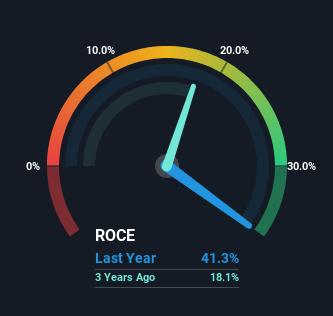- United States
- /
- Construction
- /
- NasdaqGM:IESC
Why The 41% Return On Capital At IES Holdings (NASDAQ:IESC) Should Have Your Attention

Finding a business that has the potential to grow substantially is not easy, but it is possible if we look at a few key financial metrics. Firstly, we'll want to see a proven return on capital employed (ROCE) that is increasing, and secondly, an expanding base of capital employed. This shows us that it's a compounding machine, able to continually reinvest its earnings back into the business and generate higher returns. And in light of that, the trends we're seeing at IES Holdings' (NASDAQ:IESC) look very promising so lets take a look.
Return On Capital Employed (ROCE): What Is It?
Just to clarify if you're unsure, ROCE is a metric for evaluating how much pre-tax income (in percentage terms) a company earns on the capital invested in its business. The formula for this calculation on IES Holdings is:
Return on Capital Employed = Earnings Before Interest and Tax (EBIT) ÷ (Total Assets - Current Liabilities)
0.41 = US$281m ÷ (US$1.2b - US$474m) (Based on the trailing twelve months to June 2024).
So, IES Holdings has an ROCE of 41%. In absolute terms that's a great return and it's even better than the Construction industry average of 11%.
View our latest analysis for IES Holdings

Historical performance is a great place to start when researching a stock so above you can see the gauge for IES Holdings' ROCE against it's prior returns. If you want to delve into the historical earnings , check out these free graphs detailing revenue and cash flow performance of IES Holdings.
What Can We Tell From IES Holdings' ROCE Trend?
IES Holdings is displaying some positive trends. The numbers show that in the last five years, the returns generated on capital employed have grown considerably to 41%. The amount of capital employed has increased too, by 170%. So we're very much inspired by what we're seeing at IES Holdings thanks to its ability to profitably reinvest capital.
On a separate but related note, it's important to know that IES Holdings has a current liabilities to total assets ratio of 41%, which we'd consider pretty high. This can bring about some risks because the company is basically operating with a rather large reliance on its suppliers or other sorts of short-term creditors. While it's not necessarily a bad thing, it can be beneficial if this ratio is lower.
The Bottom Line
A company that is growing its returns on capital and can consistently reinvest in itself is a highly sought after trait, and that's what IES Holdings has. And with the stock having performed exceptionally well over the last five years, these patterns are being accounted for by investors. So given the stock has proven it has promising trends, it's worth researching the company further to see if these trends are likely to persist.
One more thing to note, we've identified 1 warning sign with IES Holdings and understanding this should be part of your investment process.
If you'd like to see other companies earning high returns, check out our free list of companies earning high returns with solid balance sheets here.
New: AI Stock Screener & Alerts
Our new AI Stock Screener scans the market every day to uncover opportunities.
• Dividend Powerhouses (3%+ Yield)
• Undervalued Small Caps with Insider Buying
• High growth Tech and AI Companies
Or build your own from over 50 metrics.
Have feedback on this article? Concerned about the content? Get in touch with us directly. Alternatively, email editorial-team (at) simplywallst.com.
This article by Simply Wall St is general in nature. We provide commentary based on historical data and analyst forecasts only using an unbiased methodology and our articles are not intended to be financial advice. It does not constitute a recommendation to buy or sell any stock, and does not take account of your objectives, or your financial situation. We aim to bring you long-term focused analysis driven by fundamental data. Note that our analysis may not factor in the latest price-sensitive company announcements or qualitative material. Simply Wall St has no position in any stocks mentioned.
About NasdaqGM:IESC
IES Holdings
Designs and installs integrated electrical and technology systems, and provides infrastructure products and services in the United States.
Outstanding track record with flawless balance sheet.
Similar Companies
Market Insights
Community Narratives



